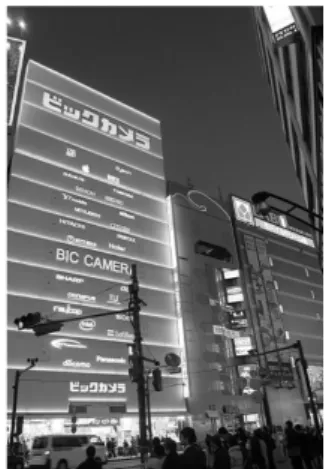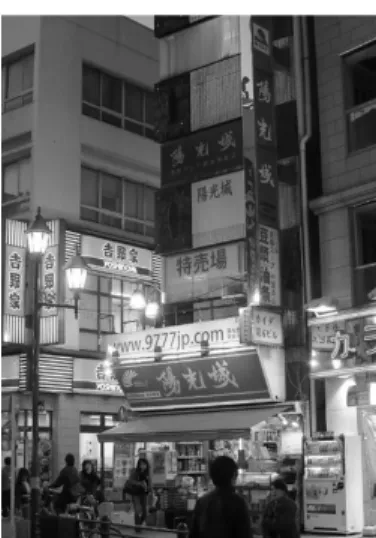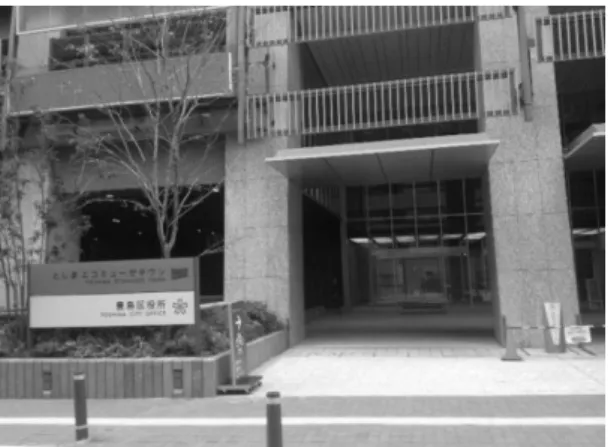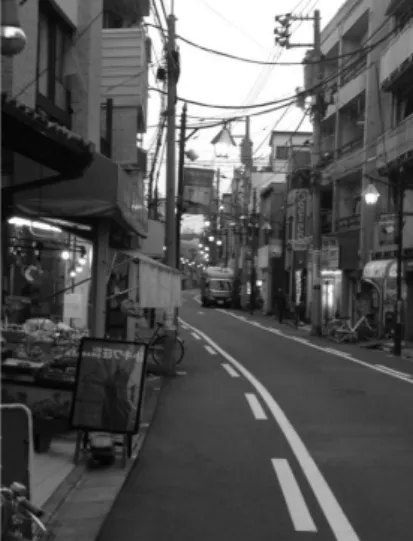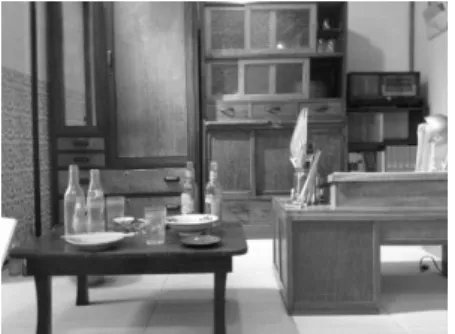Urban Regional Developments in Inner City Tokyo:
Toshima City Projects and Significant Sites of Local Cultural Heritage
MIZUKAMI Tetsuo
Abstract
This paper illustrates some prominent characteristics of urban regeneration projects within the Toshima ward of inner Tokyo, the city’s most densely populated area. The ward’s council has announced plans to develop programs for local development, some of which are related to cultural policies. Toshima ward embraces “Ikebukuro”, one of Japan’s largest terminal railway stations. Some Universities and urban amenities are also located within the ward’s boundaries. And recently, a new landmark, the Toshima city hall, has been opened in the Ikebukuro precinct. In Toshima ward, there is also a well-known apartment where popular cartoonists lived whose work has inspired the recently celebrated anime culture. Thus, one of the projects for urban regeneration has to do with Japan’s cultural heritage of comics and animations since the re-built apartment has become a site for tourism. The program announced by the ward’s council give renewed emphasis to doctrines of socio-cultural and artistic heritage for urban regeneration policy. Policy development focuses upon local heritage rather than the previous concern with developing a multicultural outlook given the diverse background of the area’s local residents. It is the decisions made by the commercial leaders in the ward’s malls who are currently shaping this feature of Toshima city’s urban regeneration.
Key words: Toshima City,
urban regeneration, manga, Tokiwa so,1.
IntroductionThis paper proposes to discuss some emerging characteristics of projects for urban regeneration that are underway in the Toshima ward of Tokyo’s inner city. This is also the site of several Universities. In recent years, the government of the Toshima ward has begun to initiate urban renewal projects. In its planning and the roll-out of its programs, the council’s contribution to local development has shifted decisively to focus upon its cultural policies. In July 2015, the Ikebukuro district in the ward was designated by the Japanese Diet as one of the 12 special urban renaissance districts across the country.
Prior to this designation, the municipality has actively been planning to make some headway with urban revitalization, and this 2015 decision served to confirm a public policy development which was already established in the ward. It was in 2007 that “The Future Plan of Toshima City” was introduced and since then the council has implemented this by continuing to develop and maintain its local projects. The ward office has since then referred to themselves as “Toshima City”, and it was this official term that had been initially used in that vision document.
社会学研究科年報 2016 №23
- 7 -
In this paper I intend to describe some characteristics of Toshima City by reference to some of its diverse local organizations and associations including local neighborhood and civic groups as well as commercial shopping malls and their business associations.
Then, I will explain some of the events that are regularly organized in the area. It should be noted that these local associations are basically organized on a voluntary or spontaneous basis, even as they regularly cooperate with or supplement the work of local government administration. These associations work in various fields of activity related to local government provision of community services. There are events such as local festivals that depend upon these associations. But there is also cleaning and scavenging work that is being done, efforts in risk management by preventing disasters and fire, and the ongoing management of a viable official liaison between local government and residents (Mizukami 1995).
Still, even if these activities are voluntary and spontaneous, the work that they do, as the social structure of their implementation, has undergone the significant changes. In some areas, these associations, while still carrying on some activities, have not been actively organizing their own local events. But in other areas, for example among shop owners in some shopping malls, there is evidence of active participation in developing community activities. Thus, we can find that in terms of Toshima City’s regeneration policies, local shopping malls are prominent in their cooperation to develop the activities that emphasize the “local cultural heritage” as part of urban renewal efforts. It is the shopping malls that we can witness the evidence of these concerted urban regeneration efforts.
2.
The Character of Toshima City with Foci upon the Ikebukuro AreaToshima ward was officially founded on 15th March 1947. It is an areas located in Tokyo’s north. Tokyo has twenty-three wards, and these are specially designated municipalities.
There are those wards which are “down-town” as well as those “up-town”. Some of these inner wards are referred to as “central Tokyo.” Because of its location, Toshima city is also designated as one of these special “central” wards. The total land area of Toshima city is 13.01 km² and as at January 2015 the population was officially estimated as 279,634. The population density is the highest of all of Tokyo’s 23 wards with 21,494 persons per km².
In addition to these numbers about actual residents, it should not be forgotten that there are
- 8 -
commuters as well. And so, during the day the population is much larger than at night. Here one can find many urban amenities and one of Tokyo’s largest terminal railway stations, Ikebukuro. The daytime population was estimated in 2010 to be 422,995 which was, at that time, one-and-a-half times the night time population of 284,678. In recent few years, permanent residential population has increased by nearly 2,000 each year, and this, in large part, has been due to the construction of several high quality apartment buildings.
According to 2014 figures, an average of
549,503 commuters (the number ofpassengers getting on and off the JR trains) use the Ikebukuro station every day. This is the second largest terminal station in Japan – Shinjuku’s count is
748,157 commuters: when including all the trains and subways at the Shinjuku station, the number is estimated to be over 3 million. At least some of the massive usage of Ikebukuro station can be explainedby the fact that Tokyo’s inner city has seen significant development of ethnic businesses.
At the same time there has also been concerted effort to develop local landmarks to emphasize the local cultural heritage as we are investigating in this article. The Ikebukuro district is therefore a central focus for this study of urban renewal, because it functions as a “nodal point” for our study: this is the place where visitors and tourists coincide with significant commercial interests that are seeking increased business opportunities.
Toshima City is indeed a precinct that attracts many commuters, shoppers and tourists. As for the regular commuters, we should keep in mind that this is the location of many schools and several universities with their various campuses: there are Ikebukuro campuses for Rikkyo University, Tokyo Fukushi University (Tokyo University and Graduate School of Social Welfare), and Teikyo Heisei University. Gakushuin University, and Kawamura Gakuen Woman's University are located nearby Mejiro station. The Tokyo College of Music is also found in the Toshima area, as are the campuses of Joshi Eiyo University (Kagawa Education Institute of Nutrition), and Taisho University. And then, of course, there are the various shopping malls which have become popular destinations for consumers. Apart from the Ikebukuro districts, Komagome, Sugamo, and Otsuka also have major shopping malls.
In the Ikebukuro district, from the Ikebukuro station as the hub, we can find shopping malls radiating out. Especially prominent are two large department stores, as if standing guard, at each side of the station’s entrance. At the eastern exit of the station, flagship store of the Seibu department store (Figure 1) exists and other major electricity
社会学研究科年報 2016 №23- 9 -
shops are located nearby, including flagship stores of Big Camera (Figure 2) and Labi, those are well-known as discount electricity shops.
Figure 1: Seibu department store at the eastern side of the Ikebukuro station.
Figure 2: Big Camera at the north-east side of the station. In front of this shop, the flagship Labi shop stands.
Various smaller shops are also located in the adjacent streets. Another landmark can be Sunshine 60, which was opened in April 1978 with its 60 storied building and over 220 meters in height (Figure 3), the former site of Tokyo (Sugamo) prison. This area is now called “Ikebukuro Sunshine City” with a variety of urban amenities, including shops, restaurants, movie theaters, an aquarium, a planetarium and hotels. From the station to this shopping area, some pharmacies also exist on the streets. This area is quite popular for tourists, and in recent years it has attracted many visitors from China. The attraction here seems to be the discount electricity shops and the pharmacies.
Both eastern and western sides of the Ikebukuro station have popular spots which lure many people for various forms of urban entertainment with large department stores, various shopping malls, taverns, restaurants, and so on. In particular, some areas on both sides have received some attention from sociologists and the media since the mid-1980s because of the inflow of “newcomers” from overseas. These newcomers were chiefly from neighboring Asian countries, such as Korea, Taiwan, the Philippines, Malaysia, Pakistan, and Bangladesh.
- 10 -
Figure 3: Sunshine 60 building in November 2015.
In the late 1980s, “in the light of the changes in major demographic characteristics, ethnicity issues have become a focal point for sociological studies in Japan” (Mizukami 2008). The Ikebukuro district has particularly accepted these “newcomers” as has the Shinjuku district in Central Tokyo. In these two inner cities, “in the 1990s, many Japanese language schools were opened; some have disappeared, but others remain” (Mizukami 2015). Amongst foreign residents in Toshima city, the number of people from China has constantly grown, and in 2014, there were 11,584 Chinese and the number occupied 4.3 percent of the entire population (271,643) of the ward and accounted for 59.3 percent of the foreigners (19,533 which is 7.2 percent of the total population) (Toshima kuyakusho 2015).
The west side of the Ikebukuro station, particularly the north-west area, has become
“the subject of intense media investigation of plans that would establish a new ‘Chinatown’
since 2004-2005” (Mizukami 2015). This side is a potential commercial challenge to the eastern area, and a competitive department store, Tobu (Figure 4), stands here with various western-side shopping malls nearby.
Apart from these “consumer hot spots”, we should also note the development of ethnic businesses, particularly those that have been developed to sell Chinese cuisine and groceries.
These days the area now has its own well-known ethnic town. “The unique character of this area is ascribed to the numbers of Chinese commuters who travel to and from the precinct, as well as availing themselves of the various free Chinese papers” (Mizukami 2015).
社会学研究科年報 2016 №23
- 11 -
Figure 4: Tobu department store at the Figure 5: One of the symbolic Chinese shops, westside of the station. Yokojyo, at the north exit of the Ikebukuro station.
3. The Ikebukuro District and its Renewal Projects
Within Tokyo, some centers have developed to become the city’s various business nuclei.
When these centers have grown too large from their commercial and business concentration, serious problems have occurred causing significant financial and economic loss. For example, the heavily congested roads and the jam-packed trains used by workers and other commuters may show increased popularity and usage but with that growth comes congestion and other problems. In Tokyo, in order to avoid such congestion arising from such central functions,
“Fukutoshin (sub-metropolitan centers)” have been created. The aim has been to decentralize the central business district. As long ago at 1958 the Shinjuku, Ikebukuro, and Shibuya districts were nominated as the “sub metropolises”.
Then, in July 2015, as we have noted above, the Ikebukuro districts was nominated as one of Toshisaisei kinkyuseibi chiki [The Twelve Urban Renaissance Urgent Development Areas], and this meant a basic change to the land act. This project is disciplined by rules that have been devised to govern an international competition between cities of the Asian region.
The focus is upon local “core areas” that have been designated for special development. The government has selected some certain areas as urban centers for attracting human resources and enterprises from overseas. Toshisaisei tokubetsusochiho [The Act on Special Measures Concerning Urban Reconstruction] was enforced in June 2002, which has enabled “the designation of Tokuteitoshi-saisei kinkyuseibi chiki [Special Urban Renaissance Urgent Development Areas] and the formulation of district improvement policies for each urgent
- 12 -
redevelopment area in order to guide urban development utilizing funding and knowhow from private sectors” (Ministry of Land, Infrastructure, Transport and Tourism, 2015). It is in these terms that the Ikebukuro station and its surrounding 143-hectare area have been selected for this disciplined redevelopment that incorporates significant cultural development (see
Figure 6).
Figure 6: Special Urban Renaissance Ikebukuro District
*Some titles and area names of the map were changed from Japanese letters to Roman characters.
Source: Ministry of Land, Infrastructure, Transport and Tourism (2015).
“Toshima City’s basic concepts were initially decided by a decision of the City Assembly in March, 2003 as the guideline which indicates its view of future prospects for regional development in Toshima City. The plan considered the first quarter of the initial half of the 21st century, and it was based on a change in the previous social economic situation so
社会学研究科年報 2016 №23- 13 -
that now, with changes to the environment that surrounds Toshima City, it has been appropriately updated as of March, 2015 (March 19, 2015, City Assembly decision).”
Figure 7: The entrance of the Toshima City office
Figure 8: Toshima City Hall high rise building
Within the area for special development, Toshima City has constructed its own new landmark, the newly built Toshima city hall (Figures 7 and 8), which was opened in May 2015. It has 10 stories above the ground and 3 basement levels. The Ground and 2nd floors are designated as commercial spaces, while from the 3rd to the 9th floors the municipal offices are located. The 10th floor is a garden, maintaining “Toshima no mori (a forest of Toshima)” which has reproduced what can be found naturally within the ward.
This building is attached to an apartment block from the 11th to 49th floors.
The mayor, Mr. Yukio Takano stated as below (Toshima kuyakusho 2015):
People from all around the world have suggested to us a new direction for the city development of this district to integrate advanced cultural and creative urban development with an emphasis upon “Secure and Safe" urban development and to expect to be more so as time goes on. The “Toshima International Arts & Culture Urban Structure” will show an image of the future as a well-populated and vigorous international city.
In fact, there have been a few major precedents for this kind of city planning, but only some plans have been directly related to local cultural heritage in which local associations have cooperated in order to implement the projects.
- 14 -
4.
Manga Mecca and Local Cultural HeritagesOne of the urban regeneration projects is related to the cultural heritage of “manga” which refers to comics and animations. In Toshima city, there is a well-known apartment building where some popular cartoonists lived. It was called “Tokiwa so (Tokiwa apartment house)”
built in 1952. It became the residence of various famous cartoonists as a center for their creative work. The apartment house since 1982 has been dissolved, but since 2009 a monument of commemoration has been built nearby the original site, and now it has become a “sacred place of the cartoon”. In December 2013, “Toshima-ku Tokiwa-so dori oyasumi dokoro (A rest stop of Tokiwa apartment street in Toshima city)” was opened on Minami-nagasaki shopping mall (Figures 9 and 10). And so Toshima City’s cultural policies have facilitated local respect for the Mecca of many manga fans’, from Japan and beyond. The cartoons which flowed out from Tokiwa apartment, was the source that inspired the present anime culture. And so “cool” animation visions of Japan were established, one after another, all centering on Toshima city. In fact, the Japanese government’s policy of “Cool Japan” refers to this manga heritage and attests to the enduring attraction and cultural power of these innovative cartoonists.
Figure 9: “Toshima-ku Tokiwa-so dori oyasumi dokoro” on Minami-nagasaki shopping mall.
Figure 10: The entrance of “Toshima-ku Tokiwa-so dori oyasumi dokoro.”
社会学研究科年報 2016 №23
- 15 -
The list of cartoonists who lived at the apartment is provided by Toshima ku (2011) and it reads as follows:
In 1953 Mr. Osamu Tezuka moved into the wooden apartment which was in Shiina- machi (present Minaminagasaki) “Tokiwa so”. He left in October 1954. He is an author of the famous story of Mighty Atom [Astro Boy], Ribon no Kishi [Princess Knight]” and etc. Mr. Fujiko Hujio A, who is a co-author of Obake no Q-taro, and an author of Ninja Hattori-kun, lived in October 1954 to October 1961. Mr. Fujiko F. Fujio, who is a Doraemon’s author, was also resident from October 1954 to October 1961. Mr. Shoutarou Ishinomori, who is an author of Kamen Rider [Masked rider], Saibogu zero zero nain [Cyborg 009] and the like, was resident from May 1956 until December 1961. Mr. Fujio Akatsuka, who writes Osomatsu-kun and Tensai Bakabon [Genius Bakabon], lived there from August 1956 to October 1961. These cartoonists, with some other great masters who have contributed to the manga circle, lived in this apartment house. There were also some cartoonists who commuted to the house. And so they developed a new expressive culture of “cartoons” while spending their lifetime in the apartment seeking to improve and develop the characters and story-lines.
Inside “Toshima-ku Tokiwa-so dori oyasumi dokoro,” there are spaces to read manga or simply to sit and rest. On the second floor, a replica of the small room where those cartoonists lived in exhibited (Figure 11).
Figure 11: The replica of the room in which the famous cartoonists lived. There are some alcohol containers on the table. This indicates creativity chatting with drinks.
These places are full of memories of past generations and of existing people that bring past issues to mind. The people of this area have developed a local identity from heritage reminders like this one and so have given their assistance to implement the recent development if the city’s cultural policies and programs. Since the area is somewhat isolated, it cannot become a local core area for development in Toshima city. However, the project has some possibilities
- 16 -
to extend or cooperate with other areas due to the “cool business” associated with manga, and in this way at least to contribute to making the local area’s cultural heritage better known.
5.
ConclusionIt is notable that some shopping malls give strong evidence of promoting local historical or social heritage. Their efforts are indeed in line with the government’s heritage policy for the entire city. In fact, Toshima City’s focus upon socio-cultural and artistic heritage has become a convenient tool for developing the urban policy of the entire city. To cope with the 2020 Olympics and Paralympics, there has recently been a surge in active deliberation about the urban policies that should now guide the city center’s developments. In Toshima City, the municipal policies have particularly focused upon the social welfare, disaster-prevention, and urban revitalization. These have been developed under the banner: “Toshima: An International City of Arts and Culture.” The municipal office plans to establish a new landmark in the site of the old City Hall, constructing a performing arts complex with a theater that can seat 1,300 guests.
However, we should not overlook the fact that the government’s policies are not directly related to the other side of urban change, namely developments of ethnic businesses and even to the issues that arise from these precincts being attractive to overseas arrivals. The renewed interest in the cultural heritage of the adjacent local area has, it seems, coincided with a decline in previous multi-cultural policy emphasis. These local heritage policies are evidence of a persistent attempt to generate a stronger identity for the area within the city’s formal boundaries. In other words, the municipal cultural policies are focused more upon the local heritage rather than adequately giving attention to the multicultural context in which these heritage sites are now located. The ethnic communities we can witness attempt to develop businesses that are already associated with many tourists from overseas, mainly from China.
As the local shopping malls are also significant in terms of the area’s social heritage they are the active initiators of urban regeneration bringing together the city municipalities, the newly arrived as well as the tourists from overseas. It is the decisions made by the leaders of the malls that are considered crucial to shape Toshima City’s ongoing urban renewal.
社会学研究科年報 2016 №23
- 17 -
* This paper is a revised edition of the paper presentation “An Urban Renewal Project and Cultural Heritage: A Case of Toshima City” at the International Conference on Locality, History and Culture in Urban Regeneration held on October 30, 2015 at The University of Seoul, Korea.
References
Mizukami, Tetsuo. 2008. “Growing Diversity in the Heart: A Case of Tokyo’s Inner Suburbia,” Global Urban Studies, No.1: 29-38.
_________. 2009. “Daitoshi inna eria no henbo nikansuru ichikosatsu – Toshimaku niokeru chugokukeijyumin no zoka to shotengai no jirei o chusin ni [A Study of Social Changes in Central Tokyo: The Augmentation of the Chinese Population and the Activities of Shopping Streets in the Ikebukuro District].” Global Urban Studies, No.2: 141-156.
_________. 2014. “In’nashithi nokiki to saisei [Crises and Revitalization of Innercities].” In Y.
Matsumoto (ed.), Toshishakaigaku nyumon [Introduction of Urban Sociology], pp. 148-163.
Yuhikaku: Tokyo.
_________. 2015. “The Characteristics of Notable Ethnic Towns in Tokyo.” Global Urban Studies, No.8: 49-59.
Naikakukanbo fukuchokanho [Assistant Chief Cabinet Secretary, Japan]. 2015. “Toshi-saisei kinkyu- seibi chiki oyobi Tokuteitoshi-saisei kinkyu-seibi chikio sadameru seirei no ichibu” o kaiseisuru seirei oyobi “Chikiseibi hoshin” nituite [“The Act for Changing some parts of the Act on Special Measures Concerning Urban Reconstruction for the Urban Renaissance Urgent Development Areas and Special Urban Renaissance Urgent Development Areas” and “Regional arrangement policies”]. Naikakukanbo fukuchokanho.
Okuda, Michihiro and Junko Tajima. 1991. Ikebukuro no Ajiakei Gaikokujin - Shakaigakuteki Jittaihokoku [Asian Foreigners in the Ikebukuro District - A Sociological Portrait of Their Actual Conditions]. Tokyo: Mekon.
Toshima ku. 2011. Tokiwa so manga bunka no katuyo nikansuru chisotekichosa [Basic Research on the use of Tokiwa so’s cartoon culture]. Toshoma ku.
Van Meerkerk, Ingmar, Beitske Boonstra, and Jurian Edelenbos. 2013. “Self-Organization in Urban Regeneration: A Two-Case Comparative Research.” European Planning Studies, 21 (10): 1630–
1652.
Websites
Toshima kuyakusho [Toshima ward government]. 2015 Website. Toshimaku no tokei [Statistics on Toshima ward] (https://www.city.toshima.lg.jp/kusei/toukei/index.html).
Toshima kuyakusho [Toshima ward government]. 2015 Website. Yokoso kuchositsu e [Welcome to the Mayor’s Office] (https://www.city.toshima.lg.jp/kuse/034432/messe-ji/index.html).
- 18 -
* The figures 1-5 were author’s shots taken in November 2015, while figures 7-11 were in October 2015. The figure 6 has been accepted to insert onto this article from Naikakukanbo fukuchokanho (Assistant Chief Cabinet Secretary, Japan), and the figures 9, 10, and 11 are accepted from the Toshima ward office.
